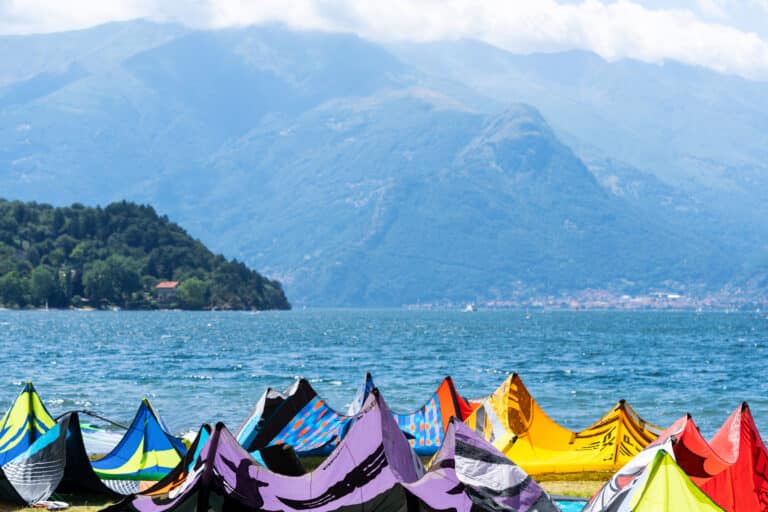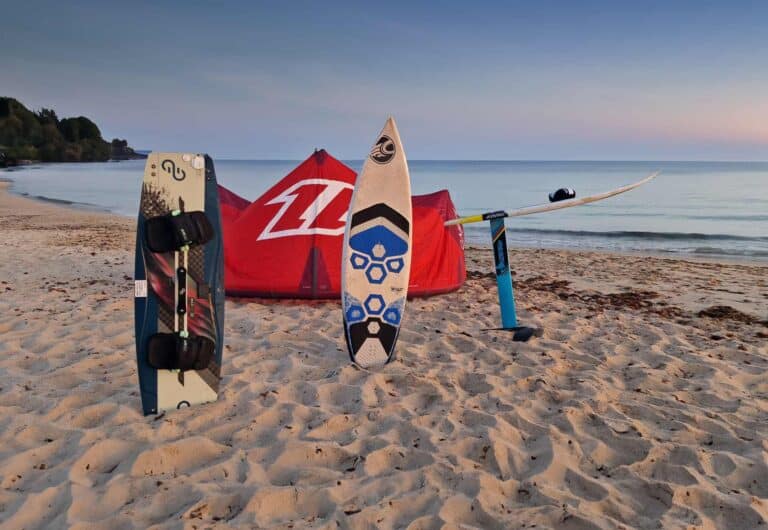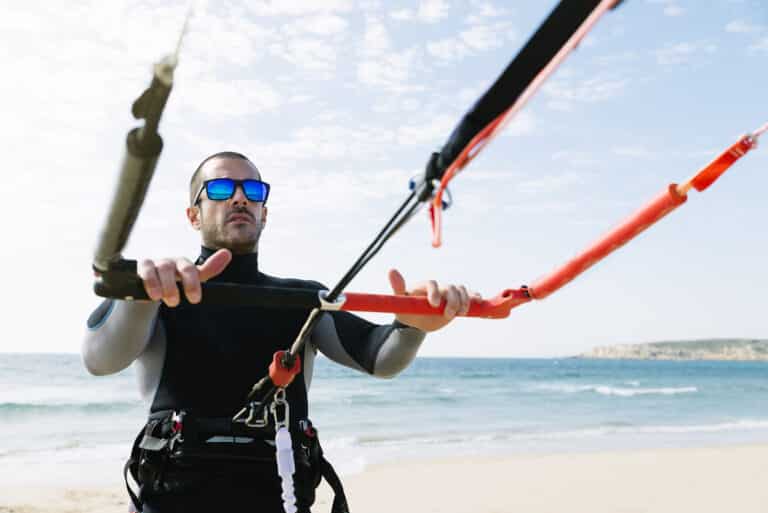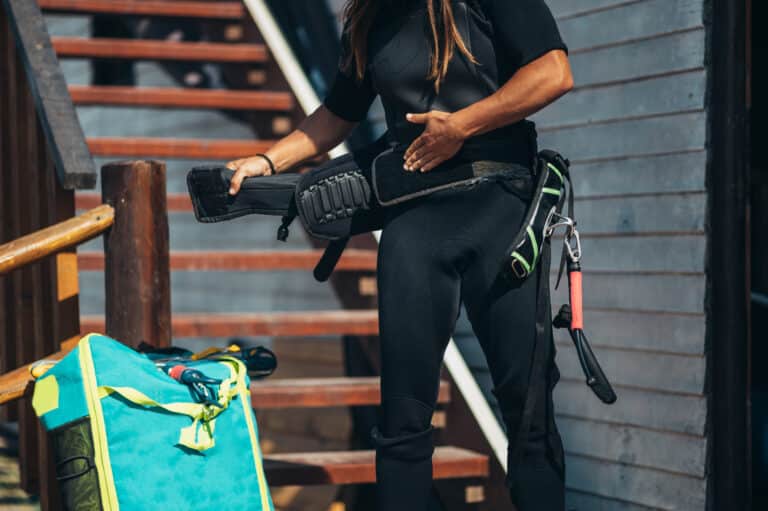How is a kite constructed?
The following video introduces the basic kite components and terminology:
Here’s a quick summary of the essential terms to give you an overview of the key parts and terminology in kiting:
- Leading Edge: Inflatable front edge, wind-facing side
- Trailing Edge: Rear edge (of the sail), downwind side
- Struts: Kite’s structural supports
- One Pump System: Pump system for inflation
- Bridling: Connection of lines to the leading edge
- Pig Tails: Line ends for connecting to the kite bar lines
What types of kites are there?
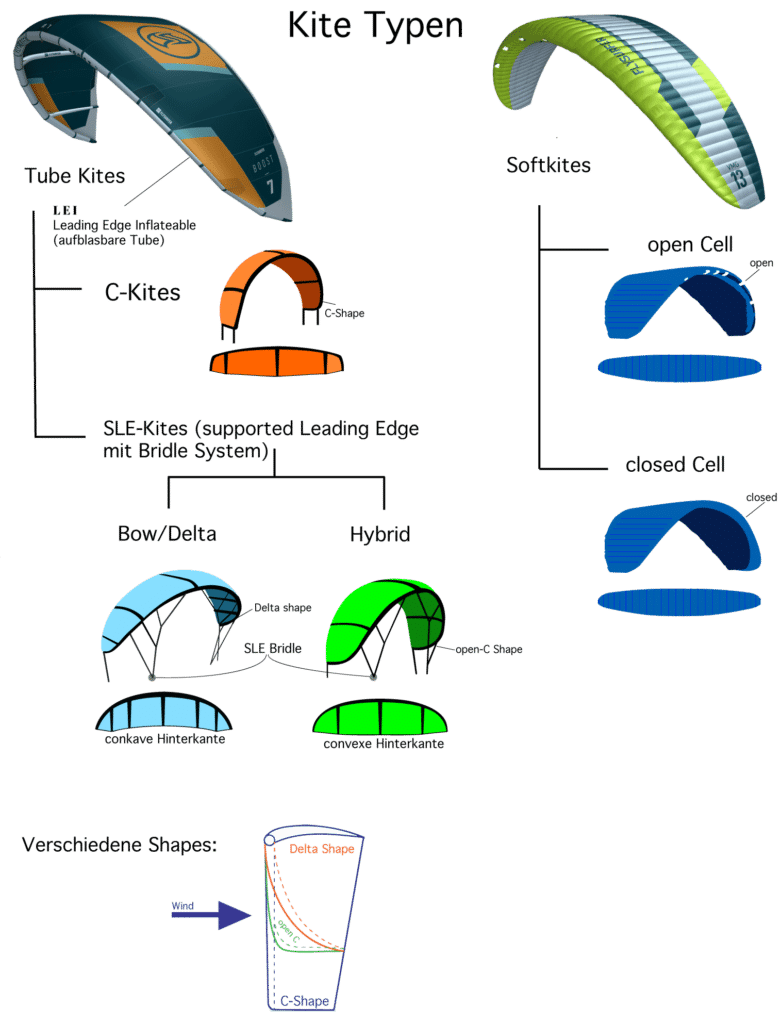
Tube Kites
Construction: Tube kites, also known as LEI (Leading Edge Inflatable) kites, have inflatable tubes along the leading edge. These tubes provide the kite with buoyancy and stability, making them ideal for use on the water, as they float and can be easily relaunched.
C-Kites
- Description: C-kites are the original form of tube kites, featuring a highly curved leading edge in the shape of a “C”. They have no bridle system and long wingtips.
- Advantages: Direct and precise control, ideal for freestyle, loops, and high, powerful jumps. Suitable for advanced kite surfers who want maximum control and power.
- Disadvantages: Limited depower potential (see glossary below), making them less versatile in varying wind conditions. They are also harder to relaunch in the water and require advanced techniques.
- Target Audience: Advanced kiters, competition kiters, and freestylers looking for powerful and aggressive jumps.
SLE-Kites (Supported Leading Edge)
SLE kites include a group of kites that use a bridle system to enhance the stability of the leading edge and make control easier. This increases wind range and depower potential (see glossary).
Delta/Bow-Kites
- Description: Delta and bow kites have a flatter profile with a convex trailing edge. Delta kites have a D-like layout, while bow kites have an even flatter profile. Both kites use bridle systems to improve stability and increase the angle of attack, maximizing depower potential and making water relaunch easier.
- Advantages: Very high depower potential and easy relaunch, ideal for beginners and freeriders. They offer a wide wind range and good control in changing wind conditions. Delta kites also provide more direct control and increased turning ability.
- Disadvantages: Less direct control compared to C-kites. Bow kites have a less “lively” riding feel.
- Target Audience: Beginners, freeriders, and kitesurfers looking for a versatile and easy-to-handle kite option.
Hybrid-Kites
- Description: Hybrid kites combine the advantages of C-kites and bow kites to create a kite with a mix of direct control and high depower. They also use a bridle system for increased stability and ease of handling.
- Advantages: Good control in all wind conditions, larger wind range than pure C-kites, and more power than bow kites.
- Disadvantages: Less aggressive than pure C-kites and less depower potential than bow kites.
- Target Audience: Advanced freestylers seeking a balanced combination of power and control.
Soft Kites (Foil Kites)
Construction: Soft kites, also known as foil kites, use an air-filled cell structure without inflatable tubes. These cells fill with air during flight, maintaining the kite’s shape. They are particularly suitable for landboarding, snowkiting, and, in some cases, water sports.
Soft Kites (Foil Kites)
- Description: These kites have open cells that fill quickly with air. They are ideal for use on snow or land and are mentioned here only for completeness.
- Advantages: Lightweight, compact, and easy to store. Very efficient in light wind and ideal for snowkiting or landboarding.
- Disadvantages: Not suitable for water use, as they sink and are difficult to relaunch when wet.
- Target Audience: Snowkiters, landboarders, advanced freeriders.
Closed Cells (Closed-Cell Foil Kites)
- Description: Closed cells prevent water from entering the kite, making them suitable for use on water.
- Advantages: Better performance in light wind and usable on water as they can float. Also suitable for racing due to high efficiency in light wind.
- Disadvantages: More expensive and complex to handle. Requires more technical knowledge than tube kites.
- Target Audience: Racers, advanced kite surfers, and freeriders looking for light wind performance.
Glossary
Wind Range: Describes the minimum and maximum wind speeds at which a kite operates efficiently. A kite with a wide wind range can be used in a variety of wind conditions, making it more versatile.
Depower: Refers to the kite’s ability to reduce pull by adjusting its angle to the wind, providing better control and safety, especially in strong winds or emergencies. Important for comfort and safety in kitesurfing.
Relaunch: The ease with which the kite can be restarted after a fall, particularly important for beginners and in variable wind conditions.
Stability: How well the kite maintains a steady flight in different wind conditions. High stability is especially important for beginners and disciplines like freeride.
Maneuverability: The kite’s ability to make quick and precise turns and perform tricks. Crucial for advanced riders and freestyle disciplines.
Portability: The weight and size of the kite when packed. A significant factor for travelers and those with limited transport space.
Who Needs Which Kite?
Beginners
Beginners should opt for bow/delta kites as these kites offer high depower potential and easy relaunch, simplifying the learning process. Their stability and user-friendliness help new kite surfers gain confidence and progress faster, allowing them to focus on learning kitesurfing basics without excessive worry over kite handling.
Intermediate Riders
Intermediate kitesurfers can choose C-kites and hybrid kites with an open-C shape, offering direct control and good performance in variable conditions. C-kites are particularly suited for freestyle and loop maneuvers, while hybrid kites offer a balanced combination of control and power, allowing advanced riders to perform complex tricks and further develop their skills.
Professionals
Professionals benefit from closed cell foil kites, which offer optimal performance and stability for competitive environments. They are highly efficient in light winds, allowing experienced kite surfers to achieve maximum efficiency and control in various disciplines like racing and freestyle.
For Detail Enthusiasts
This exciting tutorial explains the main differences between curved C-shape and flat bow kites, showing why kites with high and low aspect ratios perform differently. Learn which equipment best suits you and discover common terms essential for kite shopping. The video is in English, but you can enable German subtitles on YouTube.
Manufacturing Techniques and Materials
Structure and Construction
The construction of a kite includes components like the leading edge, struts, canopy, and lines. These elements determine stability, shape, and performance.
Leading Edge and Struts
The leading edge and struts are inflatable tubes that give the kite its structure and shape. They are crucial for stability and relaunch capability.
Canopy
The canopy is the kite’s sail, capturing the wind to create the necessary pulling force. A well-designed canopy maximizes the kite’s efficiency and performance.
Material Properties
Modern kites are made from various materials with distinct properties. Here is an overview of their advantages and disadvantages:
| Material | Advantages | Disadvantages |
|---|---|---|
| Dacron | Durable and proven, good UV and water resistance, more affordable (weight: 130-160 g/m²) | Heavier than modern materials, ages faster, moderate flexibility |
| Ripstop | NylonLightweight, good water resistance, affordable, suitable for recreational kites (weight: 60-100 g/m²) | Less durable, moderate strength, less shape stability |
| Penta TX (SLS) | High tensile strength, lighter than Dacron, good UV resistance, high performance (50% lighter than Dacron) | More expensive than standard materials, limited to high-end models |
| Aluula | Extremely lightweight, high strength (nearly seven times tear resistance of Dacron at half the weight), excellent UV and water resistance, very durable (weight: 82 g/m²) | Higher cost, primarily for high-end kites |
Seams and Reinforcements
Seams must be extremely robust to withstand high loads. Reinforcements in critical areas increase durability.
Lightweight Construction
Modern manufacturing techniques enable the production of lightweight kites that are still durable, improving handling and responsiveness.
Here’s a quick overview of how a kite is made:
How to Choose the "Right" Kite
Based on Wind Conditions and Skill Level
A kite with a wide wind range and good depower ability, like a bow or hybrid kite, is ideal for beginners. Advanced kite surfers may opt for high-performance C-kites.
Kite Size and Rider’s Body Weight
Kitesurfing equipment manufacturers often provide customized size charts, which are essential as different kite designs offer various performance ranges and wind ranges. For example, lighter riders might need a larger kite in low winds, while heavier riders should consider a smaller kite for optimal control. These specific recommendations help you find the right size for your individual needs and prevailing weather conditions.
Kite Sizes and Different Boards
Different boards, like twin tips, directional boards, and hydrofoil boards, require different kite sizes:
- Twin Tips: These versatile boards generally need medium to larger kites to provide enough pull.
- Directional Boards: Often used for wave riding, these boards typically require slightly smaller kites since the boards cut through the waves more efficiently.
- Hydrofoil Boards: Smaller kites are necessary here, as hydrofoil boards create less drag and are more efficient at lower wind speeds.
